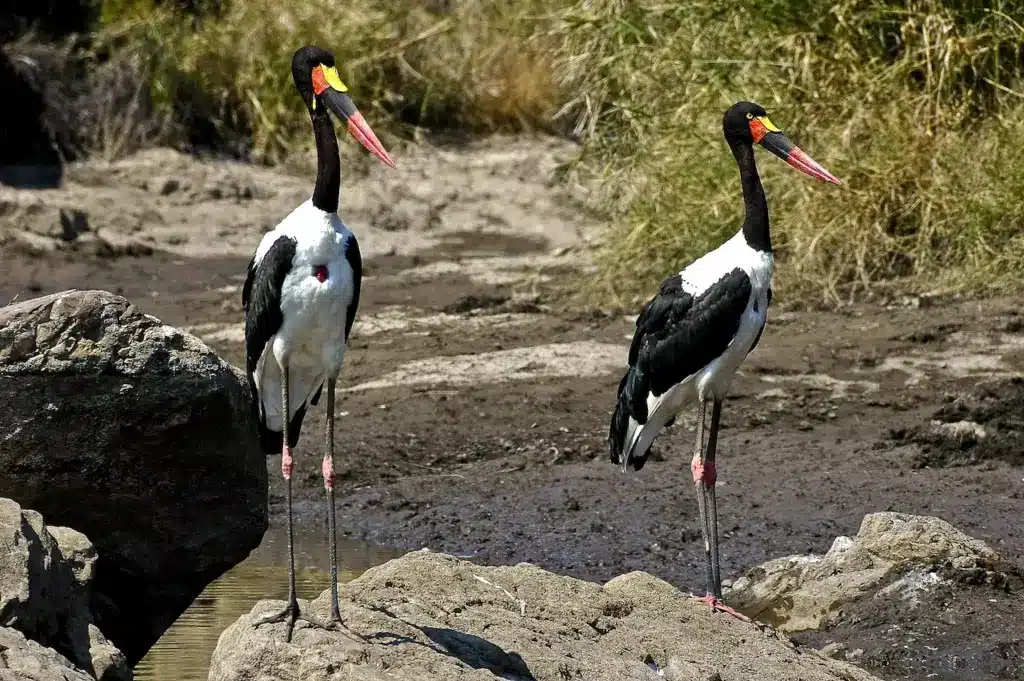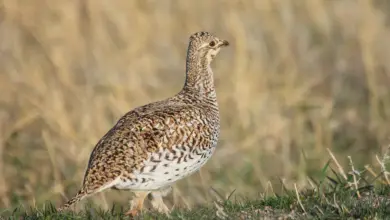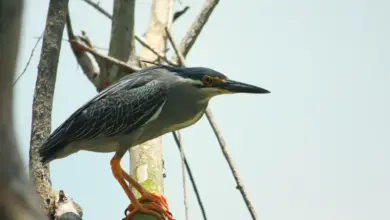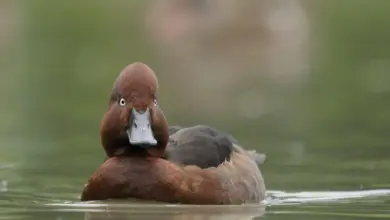Storks are large, long-legged, long-necked wading birds with long stout bills, belonging to the family Ciconiidae. Most storks eat frogs, fish, insects, earthworms, and small birds or mammals.

Storks are large, long-legged, long-necked wading birds with long stout bills, belonging to the family Ciconiidae. They occur in most of the warmer regions of the world and tend to live in drier habitats than the related herons, spoonbills and ibises; they also lack the powder down that those groups use to clean off fish slime. Storks have no syrinx (= sound-producing vocal organ) and are mute, giving no bird call; bill-clattering is an important mode of stork communication at the nest. Many species are migratory. Most storks eat frogs, fish, insects, earthworms, and small birds or mammals. There are 19 species of storks in six genera.
Storks tend to use soaring, gliding flight, which conserves energy. Soaring requires thermal air currents. Ottomar Anschütz’s famous 1884 albumen photographs of storks inspired the design of Otto Lilienthal’s experimental gliders of the late 19th century. Storks are heavy with wide wingspans, and the Marabou Stork, with a wingspan of 3.2 m (10.5 feet), shares the distinction of “longest wingspan of any land bird” with the Andean Condor.
Their nests are often very large and may be used for many years. Some have been known to grow to over 2 m (6 feet) in diameter and about 3 m (10 feet) in depth. Storks were once thought to be monogamous, but this is only true to a limited extent. They may change mates after migrations, and migrate without them. They tend to be attached to nests as much as partners.
Storks’ size, serial monogamy, and faithfulness to an established nesting site contribute to their prominence in mythology and culture.
Etymology
The modern English word comes from Old English “storc”, which is in turn related to “stark”, probably in reference to the bird’s stiff or rigid posture.
Originally from Proto Germanic *sturkaz (compare Old Norse storkr, and Old High German storah, all meaning stork). Nearly every Germanic language has a form of this proto-language to indicate the stork; the Dutch exception, apparently originating in a euphemism, may signify the presence of a deep-seated taboo: compare “bear”.
| Language | A word used for “Stork” |
|---|---|
| Danish | stork |
| German | Storch |
| Low Saxon | Stork |
| Dutch | Ooievaar* |
| Norwegian | stork |
| Swedish | Stork |
* Dutch is an exception within the Germanic language group.
Old Church Slavonic struku, Russian стерх (pronounced sterkh, meaning Siberian White Crane), Lithuanian starkus, Hungarian eszterag (rarely used; commonly gólya) and Albanian sterkjok are all Germanic loan-words.
Rarely the word’s origin is linked to Greek torgos meaning “vulture”.
The fable that babies are brought by storks is mainly from Dutch and Northern German nursery stories, no doubt from the notion that storks nesting on one’s roof meant good luck, often in the form of family happiness.

Species
- Family Ciconiidae
- Genus Mycteria
- Milky Stork (Mycteria cinerea)
- Yellow-billed Stork (Mycteria ibis)
- Painted Stork (Mycteria leucocephala)
- Wood Stork (Mycteria americana)
- Genus Anastomus
- Asian Openbill Stork, Anastomus oscitans
- African Openbill Stork, Anastomus lamelligerus
- Genus Ciconia
- Abdim’s Stork, Ciconia abdimii
- Woolly-necked Stork, Ciconia episcopus
- Storm’s Stork, Ciconia stormi
- Maguari Stork, Ciconia maguari
- Oriental White Stork, Ciconia boyciana
- White Stork Ciconia ciconia
- Black Stork Ciconia nigra
- Genus Ephippiorhynchus
- Black-necked Stork, Ephippiorhynchus asiaticus
- Saddle-billed Stork, Ephippiorhynchus senegalensis
- Genus Jabiru
- Jabiru Jabiru mycteria
Genus Leptoptilos
- Lesser Adjutant, Leptoptilos javanicus
- Greater Adjutant, Leptoptilos dubius
- Marabou Stork, Leptoptilos crumeniferus
- Genus Mycteria
Symbolism of storks
The white stork is the symbol of The Hague in the Netherlands and the unofficial symbol of Poland, where about 25 percent of European storks breed.
In Western culture, the White Stork is a symbol of childbirth. In Victorian times the details of human reproduction were difficult to approach, especially in reply to a child’s query of “Where did I come from?”; “The stork brought you to us” was the tactic used to avoid discussion of sex. This habit was derived from the once popular superstition that storks were the harbingers of happiness and prosperity.
The image of a stork bearing an infant wrapped in a sling held in its beak is common in popular culture. The small pink or reddish patches often found on a newborn child’s eyelids, between the eyes, upper lip, and the nape of the neck, which are clusters of developing veins that soon fade, are sometimes still called “stork bites”.
Vlasic brand pickles in North America use this child-bearing stork as a mascot.

Mythology of storks
Most of these myths tend to refer to the White Stork.
- In Ancient Egypt the stork was associated with the human ba; they had the same phonetic value. The ba was the unique individual character of each human being: a stork with a human head was an image of the ba-soul, which unerringly migrates home each night, like the stork, to be reunited with the body during the Afterlife.
- The motto “Birds of a feather flock together” is appended to Aesop’s fable of the farmer and the stork his net caught among the cranes that were robbing his fields of grain. The stork vainly pleaded to be spared, being no crane.
- The Hebrew word for stork was equivalent to “kind mother”, and the care of storks for their young, in their highly visible nests, made the stork a widespread emblem of parental care. It was widely noted in ancient natural history that a stork pair will be consumed with the nest in a fire, rather than fly and abandon it.
- In Greek mythology, Gerana was an Æthiope, the enemy of Hera, who changed her into a stork, a punishment Hera also inflicted on Antigone, daughter of Laomedon of Troy (Ovid, Metamorphoses 6.93). Stork-Gerana tried to abduct her child, Mopsus. This accounted, for the Greeks, for the mythic theme of the war between the pygmies and the storks. In popular Western culture, there is a common image of a stork bearing an infant wrapped in cloths held in its beak; the stork, rather than absconding with the child Mopsus, is pictured as delivering the infant, an image of childbirth.
- The stork is alleged in folklore to be monogamous although in fact this monogamy is “serial monogamy”, the bond lasting one season: see above. For Early Christians the stork became an emblem of a highly respected “white marriage”, that is, a chaste marriage. This symbolism endured to the seventeenth century, as in Henry Peacham’s emblem book Minerva Britanna (1612) (see link).
- Though “Stork” is rare as an English surname, the Czech surname “Čapek” means “little stork”.
- For the Chinese, the stork was able to snatch up a worthy man, like the flute-player Lan Ts’ai Ho, and carry him to a blissful life.
- In Norse mythology, Hoenir gives to mankind the spirit gift, the óðr that includes will and memory and makes us human (see Rydberg link). Hoenir’s epithets langifótr “long-leg” and aurkonungr “mire-king” identify him possibly as a kind of stork. Such a Stork King figures in northern European myths and fables. However, it is possible that there is confusion here between the White Stork and the more northerly-breeding Common Crane, which superficially resembles a stork but is completely unrelated.
- In Bulgarian folklore, the stork is a symbol of the coming spring (as this is the time when the birds return to nest in Bulgaria after their winter migration) and in certain regions of Bulgaria it plays a central role in the custom of Martenitsa: when the first stork is sighted it is time to take off the red-and-white Martenitsa tokens, for spring is truly come.
- A series of sightings of a mysterious pterodactyl-like creature in South Texas’ Rio Grande Valley in the 1970s has been attributed to an errant giant stork that became lost during a migratory flight and wound up in an unfamiliar region.
Copyright: Wikipedia. This article is licensed under the GNU Free Documentation License. It uses material from Wikipedia.org … Additional information and photos added by Avianweb.
Please Note: The articles or images on this page are the sole property of the authors or photographers. Please contact them directly with respect to any copyright or licensing questions. Thank you.





